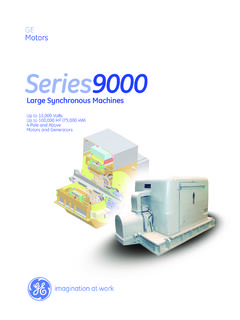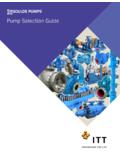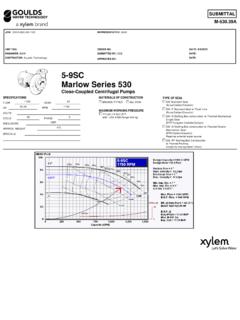Transcription of Optimizing Total Cost of Ownership (TCO) - Argo …
1 White Paper Optimizing Total cost of Ownership (TCO) Tom Dabbs Reliability Specialist Plant Performance Services Group, ITT Executive Summary Though many plants shop for equipment based on price, industry data shows that purchase costs represent only 10 percent of the Total cost of Ownership (TCO). This white paper shares the formula for analyzing TCO as part of purchase and design decisions, with case studies showing how five organizations use a TCO approach to yield dramatic savings. Contents The TCO Formula .. 2 Specifying the right size pump.
2 4 Case study 1: Too much suction causes too many failures .. 5 Acquisition cost and performance tradeoffs .. 5 Case study 2: Non-OEM parts go up in smoke .. 6 Managing inventory .. 7 Case study 3: Parts problem at paper plant .. 7 Ensuring quality repairs .. 8 Case study 4a: 700 maintenance challenges at chemical plant .. 8 Case study 4b: Oil refinery reforms bad actors .. 8 Role of operations and maintenance in managing TCO .. 9 TCO analysis A powerful tool .. 9 About ITT .. 10 Page 2 of 10 Optimizing Total cost of Ownership (TCO) How much does a pump cost ?
3 Ask a corporate executive or plant manager about the cost of a piece of equipment, and you re likely to hear the purchase price. In fact, however, capital outlay is only a fraction of Total operating expenses for rotating equipment. Companies that want to compete effectively should carefully measure Total costs, and analyze them as part of system design and equipment purchase decisions. As Lord Kelvin, the renowned British physicist, mathematician and engineer, said in 1883: "When you can measure what you are speaking about, and express it in numbers, you know something about it; but when you cannot measure it, when you cannot express it in numbers, your knowledge is of a meager and unsatisfactory kind.
4 " When managers measure and analyze the elements of Total cost of Ownership (TCO) sufficiently to understand and optimize them better than anyone else, their organization is likely to be an industry leader. Fittingly, Lord Kelvin also said this about the value of analysis: "The more you understand what is wrong with a figure, the more valuable that figure becomes." Optimizing TCO is a difficult process for organizations to plan and sustain, but this white paper contains multiple case studies that show the payoff is worth the effort.
5 Most organizations that succeed at Optimizing TCO have leaders who demand cooperation between functional groups. They recognize that Optimizing costs is a function of operations, maintenance and the purchasing department working toward the common goal of lowering Total costs. They also insist on the discipline to always follow proper work processes. The TCO Formula Total cost of Ownership analysis is simply a financial estimate of all costs direct and indirect of acquiring, commissioning, operating, maintaining and disposing of a product or system for a specified period of time.
6 The analysis can be used to effectively compare alternative approaches. One can understand these costs by using this model for pumping systems that can be extended to almost any class of manufacturing equipment: TCO = Ca + Cc + Co +Cm + Cp + Cd Page 3 of 10 Where: Ca= cost of Acquisition includes the cost of engineering, procurement, equipment cost , auxiliary equipment cost , inspections and documentation. Cc= cost of Commissioning includes the cost of construction, testing, training and technical support. Co= cost of Operation includes energy, operating personnel, facility costs, support and handling for raw materials.
7 Cm= cost of Maintenance includes maintenance personnel, maintenance facility cost , test equipment, maintenance support and handling cost , maintenance spares and repair parts. Cp= cost of Production includes production losses, quality cost , environmental cost and cost of redundancy. Cd=Removal and Disposal cost minus any reclamation value. ITT also has adopted benchmarks for the typical weight of different cost factors that comprise TCO, as seen in Figure 1. Taken from a top-10 global chemical manufacturer, this breakdown allows us to compare a customer s actual costs to a sample of industry data.
8 It is interesting to note that initial cost typically represents less than 10 percent of TCO. Energy and maintenance costs have at least five times more relevance, but are rarely considered during the selection process. The adage, Pay me now or pay me later, can ring painfully true for managers who don t look at the entire picture. Figure 1. Source: Top 10 Global Chemical Manufacturer, FY 2006 Page 4 of 10 Specifying the right size pump The first opportunity to optimize TCO is during the design phase. Specifying the right equipment for the right application is critical to operating efficiently which lowers the energy, operation and maintenance expenses that comprise more that 60 percent of Total cost of Ownership .
9 Many engineers specify oversized pumps, on the theory that it is better to err on the side of having too much power for the application than too little. If the flow of the system is too high coming out of the pump, it simply can be throttled back using a valve on the discharge side. This arrangement is a very inefficient and costly way to configure a system. It increases energy costs for operating the pump, reduces the operating life of the equipment and likely increases downtime. To understand why, it s important to know the basics of how a pump works.
10 Centrifugal pumps operate with a rotating impeller, which imparts velocity energy to the liquid. The impeller accelerates the liquid and discharges it into the casing, and as the casing area increases, the velocity energy is converted to pressure. Higher velocity brings higher pressure. Pumps are designed for specific flow ranges. When a pump is operating optimally or at its Best Efficiency Point (BEP) liquid flow is constant and radial forces acting on the impeller are balanced. This allows the pump to experience the highest efficiencies and lowest vibration.




